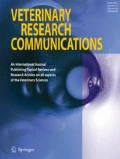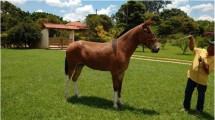Abstract
Haematological estimations and serum biochemical analyses were made on 100 samples collected from clinically healthy ‘Hijin’ racing camels (Camelus dromedarius) in Kuwait. The red blood cell counts, packed cell volume, haemoglobin concentration, mean corpuscular volume, mean corpuscular haemoglobin, mean corpuscular haemoglobin concentration and total white blood cell counts were estimated. In the serum biochemical analyses, sodium, potassium, iron, calcium, phosphorus, magnesium, total bilirubin, blood urea nitrogen, creatinine, glucose, total protein and cholesterol concentrations were measured, as were the alanine aminotransferase, aspartate aminotransferase, γ-glutamyltransferase, creatine kinase and alkaline phosphatase activities. The results are discussed in relation to other findings reported in camels.
Similar content being viewed by others
REFERENCES
Abdelgadir, A.W., Salaheldin, E.A., Neimat, A.A. and Omer, F.I., 1979. Plasma electrolytes and minerals of normal camels in the Sudan. In: IFS Provisional Report No. 6, Camels, (International Foundation for Science, Stockholm), 355–364
Al-Ali, A.K., Al-Husayni, H.A. and Power, D., 1988. A comprehensive biochemical analysis of the blood of the camel Camelus dromedarius. Comparative Biochemistry and Physiology, 89B, 35–37
Al-hadrami, G.A., 1997. Comparative haematology in the camel calf and adult racing camel (Camelus dromedarius). Journal of Camel Practice and Research, 4, 13
Beaunoyer, D.E., 1992. Changes in serum activities after maximal exercise in camels. In: Proceedings of the 1st International Camel Conference, Dubai, 331–333
Bengoumi, M., Faye, B., De La Farge, F., Olson,W.G. and Rico, A.G., 1997. Clinical enzymology in the dromedary camel (Camelus dromedarius). Journal of Camel Practice and Research, 4, 19–23
Coles, E.H., 1986.Veterinary Clinical Pathology, 4th edn, (W.B. Saunders, Philadelphia), 455
El-Gayoum, S.E.A., 1986. Study on the mechanism of resistance to camel diseases, (Dissertation, Gö ttingen University, Heft 22)
Evans, D.I., Rose, R.J., Knight, P.K., Cluer, D. and Mannefield, G., 1992. Physiological responses during an incremental treadmill exercise test in the camel. In: Proceedings of the 1st International Camel Conference, Dubai, 223–227
Ghodsian, I., Nowrouzian, I. and Schels, H.F., 1978. A study of some haematological parameters in the Iranian camel. Tropical Animal Health and Production, 10, 109–110
Harris, R.C. and Hultman, E., 1992. Nutritional strategies for enhanced performance in the racing camel: lessons learned from man and horse. In: Proceedings of the 1st Camel Conference, Dubai, 243–246
Higgins, A.J., 1986. The clinical examination of the camel. In: The Camel: Development Research, Proceedings of Kuwait Seminar, (Food and Agriculture Organization, Rome), 131–144
Kohnke, J. and Cluer, D., 1992. Practical feeding and nutrition of racing camels: a preliminary study. In: Proceedings of the 1st Camel Conference, Dubai, 247–250
Lakhotia, R.L., Bhargava, A.K. and Mehrotra, P.N., 1964. Normal ranges for some blood constituents of the Indian camel.Veterinary Record, 76, 121–122
Little, A., McKenzie, A.J., Morris, R.J.H., Robert, J. and Evans, J.V., 1970. Blood electrolytes in the Australian camel. Australian Journal of Experimental Biology and Medical Science, 48, 17–24
Manefield, G.W. and Tinson, A.H., 1996. Camels: A Compendium, (University of Sydney Post Graduate Foundation in Veterinary Science, Sydney, Australia)
Mathur, G.N., Ghosal, A.K. and Bhatia, J.S., 1980. Note on certain blood constituents in the Indian camel. Indian Journal of Animal Science, 51, 1179–1180
Mills, J.N. and Valli, V.E.O., 1988. The haematopoietic system. In: W.F. Robinson and C.R.C. Huxtable (eds), Clinicopathologic Principles for Veterinary Medicine, (Cambridge University Press, Cambridge), 33–84
Mohamed, H.A. and Hussein, A.N., 1999. Tayr syndrome: a neurological disorder in a racing camel (Camelus dromedarius). Camel Newsletter, 15, (in press)
Nyang'ao, J.M.N., Olahu-Mukanio, W., Maribei, J.M. and Omuse, J.K., 1997. A study of some haematological and biochemical parameters of the normal dromedary camel in Kenya. Journal of Camel Practice and Research, 4, 31–33
Pratt, P.W., 1992. Laboratory Procedures for Veterinary Technicians, 2nd edn, (American Veterinary Publications, Goleta, CA), 18–27
Radostits, O.M., Blood, D.C. and Gay, C.C., 1994. Veterinary Medicine: A Textbook of the Diseases of Cattle, Sheep, Pigs, Goats and Horses, 8th edn, (Baillière Tindall, London), 96
Rezakhani, A., Naziff Habibabadi, S. and Maghrebi Ghojogh, M., 1997. Studies on normal haematologi-cal and biochemical parameters of Turkmen camel in Iran.Journal of Camel Practice and Research, 4, 41–44
Salaheldin, E.A., Abdelgadir, A.W. and Omer, F.I., 1979. Biochemical studies of some blood and plasma constituents on camel (Camelus dromedarius). In: IFS Provisional Report No. 6, Camels, (International Foundation for Science, Stockholm), 365–372
Saltin, B. and Rose, R.J. (Editors) 1991. The Racing Camel: Physiology, Metabolic Functions and Adaptations, (Acta Physiologica Scandinavica, Supplementum 617). Blackwell Scientific Publications, Oxford, UK
Sarwar, A. and Majeed, M.A., 1997. Interrelationships between 30 parameters of blood in normal one-humped camel in summer. Journal of Camel Practice and Research, 4, 35–39
Snow, D.H., 1992. An introduction to the racing camel. In: Proceedings of the 1st Camel Conference, Dubai, 215–217
Snow, D.H., Billah, A. and Ridha, A., 1988. Effects of maximal exercise on the blood composition of the racing camel.Veterinary Record, 123, 311–312
Werney, U. and Kaaden, O.-R., 1995. Infectious Diseases of Camelids, (Blackwell Wissenschafts-Verlag, –Berlin)
Author information
Authors and Affiliations
Rights and permissions
About this article
Cite this article
Mohamed, H., Hussein, A. Studies on Normal Haematological and Serum Biochemical Values of the ‘Hijin’ Racing Camels (Camelus dromedarius) in Kuwait. Vet Res Commun 23, 241–248 (1999). https://doi.org/10.1023/A:1006253210461
Issue Date:
DOI: https://doi.org/10.1023/A:1006253210461



